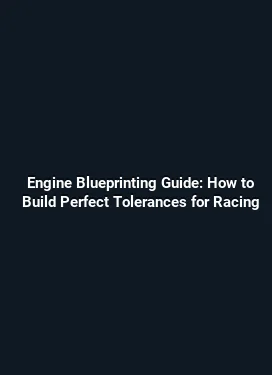How to Read and Interpret Dyno Charts for Engine Performance
Dyno charts are powerful tools for optimizing engine performance, diagnosing drivability concerns, and validating tuning changes. A well-interpreted dyno chart provides a clear picture of how an engine responds across RPM ranges under controlled conditions. This guide delves into the practical aspects of reading dyno data, understanding the key metrics, and applying insights to real-world tuning scenarios. By exploring both the numerical values and the shape of the curves, enthusiasts and professionals can make informed decisions about ignition timing, fueling strategies, and mechanical upgrades without relying on guesswork.
Understanding the Structure of a Dyno Chart

A typical dyno chart presents power and torque curves plotted against engine speed, usually measured in revolutions per minute (RPM). Some charts also include supplementary lines for air-fuel ratio (AFR), boost pressure, and exhaust gas temperature. When interpreting these charts, it is essential to consider the test setup, including load mode (engine brake, hub load, or load cell), the correction factor applied to power readings (SAE, STD, or SAE-J1349), and the ambient conditions during the run. These factors can influence the absolute numbers, but the shape of the curves under consistent conditions remains highly informative for comparing tuning strategies and mechanical changes.
Two of the most important metrics on any dyno chart are horsepower (HP) and torque (TQ). Horsepower represents the rate at which work is done by the engine, while torque measures twisting force at the crankshaft. The peak values, their RPM locations, and the width of the hills (how broad or narrow the peaks are) convey how an engine performs across the usable RPM range. Additionally, the slope of the curves—often described as the acceleration or elevation aspect—reveals how quickly the engine responds to throttle input and how the power band shifts with different calibrations or hardware changes.
Key Dyno Metrics and Their Practical Implications
When evaluating a dyno chart, certain metrics deserve close attention because they directly influence driveability, efficiency, and power potential. Below are the core elements to focus on and how to translate them into tuning decisions.
Key Dyno Metrics and Their Interpretations

Peak horsepower and the RPM at which it occurs: The peak HP value shows the maximum sustained power delivered by the engine. Its RPM location indicates the engine’s effective power band. If peak HP occurs at very high RPM, the engine may feel strong only near the upper revs, potentially sacrificing low- to mid-range responsiveness. Tuning approaches to adjust this include altering ignition timing, refining fuel delivery, and addressing mechanical limitations such as compression ratio or turbo sizing.
Peak torque and its RPM: Torque is closely related to the engine’s ability to accelerate and pull through gears. A broad torque curve with a strong middle region often yields better everyday performance, even if peak HP is modest. If torque falls off quickly after the midrange, it may indicate late timing spikes, restrictive exhaust, or fueling that leans off as RPM climbs. Tuning fixes can involve optimizing spark advance in the midrange, smoothing AFR transitions, or revisiting intake and exhaust flow paths.
Air-fuel ratio (AFR) during a pull: AFR reflects the balance between fuel and air. A well-tuned engine maintains a safe and efficient AFR across the RPM range, typically around stoichiometric for naturally aspirated engines or a slightly richer mixture for forced-induction setups under boost. Dramatic AFR swings indicate tuning instability, vacuum leaks, or sensor calibration issues. Interpreting AFR trends alongside HP and TQ helps pinpoint whether fuel strategy or ignition timing is driving performance changes.
Boost pressure and its correlation with power: In forced-induction engines, boost influences the amount of air entering the cylinders. A stable rise in boost with RPM that aligns with a proportional increase in HP suggests a healthy turbocharger or supercharger system. Any lag, spike, or plateau in boost can signal wastegate tuning needs, intercooler efficiency limitations, or compressor map constraints. Aligning boost with the torque curve helps maximize usable power without compromising reliability.
Torque to horsepower ratio: The relationship between torque and horsepower is governed by RPM. Close attention to how HP responds to increases in RPM relative to torque helps in predicting acceleration characteristics and gearing choices. A mismatch, where HP climbs while torque drops, might indicate torque management or fueling issues that prevent the engine from exploiting higher RPMs.
Engine speed stability and repeatability: Consistency across runs matters for reliable interpretation. Small variations may stem from ambient conditions, throttle response, or transmission behavior. Repeated runs with identical test setups improve confidence in trends and reduce noise in the data.
Spinner lines for ancillary data: Some charts include additional indicators for air temperature, barometric pressure, humidity, or inertia correction. These context lines help explain deviations between runs and support more accurate comparisons when evaluating different tunes or hardware configurations.
From Numbers to Tuning Actions: Practical Scenarios
Reading dyno charts is most valuable when the data translates into actionable tuning steps. Below are common scenarios and the corresponding interpretations that guide modifications in ignition timing, fueling, and hardware adjustments.
Scenario 1: Strong midrange torque but a flat top-end
Observation: The torque curve climbs rapidly and peaks around midrange but falls off before reaching high RPM, while HP continues to rise modestly. AFR remains relatively rich at the top end, and boost stabilizes but does not sustain higher RPM gains.
Interpretation and actions: This pattern suggests a midrange boost in efficiency with potential fueling or timing constraints at higher RPMs. Consider gradually advancing ignition timing in the upper midrange to extract more energy from the charge, while ensuring AFR stays within safe limits to avoid detonation. Inspect exhaust backpressure and check for compressor surge or intercooler inefficiency that could choke high-RPM power. If a turbo or blower is in use, evaluate boost control strategy to maintain consistent pressure through the top end.
Scenario 2: Lean spike at higher RPMs
Observation: AFR trends toward lean values as RPM increases, with HP plateauing or dipping despite continued engine speed. Torque also flattens in the upper RPM region.
Interpretation and actions: A lean spike at high RPM often points to fueling limitations or injector duty cycle reaching its maximum. Actions include increasing injector size or duty cycle ceiling, adjusting fuel map scaling for high-RPM cells, or addressing fuel pump capacity. Additionally, inspect intake airflow, MAF/MAP sensor calibration, and potential vacuum leaks that become more pronounced under high load. Confirm that the timing remains within safe margins to prevent detonation when richer fueling is required to protect the engine.
Scenario 3: Boost ramp not aligning with power gains
Observation: Boost climbs smoothly with RPM, but horsepower gains lag behind expected levels, and torque does not track boost as anticipated. The chart may show delayed horsepower response relative to boost onset.
Interpretation and actions: This scenario indicates inefficiencies in the charging system or in the intercooling path. Potential fixes include upgrading intercooler efficiency, reducing intake air temperature, checking for leaks in intercooler piping and vacuum lines, and ensuring the wastegate is properly calibrated to match the desired boost curve. A deeper look at the turbo compressor map and turbine efficiency may reveal flow limitations that cap power gains at high RPMs.
Advanced Topics: Trend Kinetics, Semantics, and Data Integrity
Beyond the basics, modern dyno analysis benefits from exploring trend kinetics and semantic awareness of the data. Trend kinetics involve observing how small adjustments cascade into larger performance shifts across multiple runs, helping to validate tuning decisions and avoid chasing noise. Semantic understanding refers to interpreting data in the context of the engine’s design, such as the forced induction setup, cam timing strategy, and fuel delivery topology. Both aspects rely on a careful, iterative approach to data collection and interpretation, ensuring that changes made on the dyno translate to predictable improvements on the road or track.
In practice, engine management software allows mapping strategies that link fuel, timing, and boost to operating conditions like RPM, load, and temperature. When reviewing charts, keep a mental checklist: verify calibration consistency, compare identical test conditions, examine the effect of one variable at a time, and document the impact on the power band. This disciplined approach reduces ambiguity and accelerates the path from data to reliable gains in real-world performance.
Testing Protocols: How to Build Reliable Dyno Data
Reliable dyno results require systematic testing. The best practice involves standardized procedures that minimize variables and highlight genuine performance changes. Key elements include instrument calibration, consistent traction, uniform coolant and oil temperatures, and controlled load conditions. It is also helpful to perform multiple pulls at similar RPM ranges to assess repeatability and to test under different operating modes (steady-state vs. sweep), ensuring a robust data set that captures the engine’s behavior under diverse scenarios.
Additionally, documenting the test environment—ambient temperature, humidity, barometric pressure, and vehicle weight—creates a baseline for comparing runs. When the data is shared with a community or used for benchmarking, clear context helps others reproduce results and understand the tuning decisions behind the curves. A disciplined approach to data integrity ultimately yields more meaningful insights and faster progress in performance goals.
Practical Tips for Interpreting Dyno Data
Learning to read dyno charts is an iterative process that rewards attention to detail and a methodical approach. The following practical tips help translate chart data into productive tuning actions without relying on guesswork.
Practical Tips for Reading Dyno Data
Compare apples to apples: Use the same test conditions when comparing different tunes or hardware configurations. Small shifts in ambient conditions or test setup can masquerade as performance differences if not controlled.
Look at the shape, not just the numbers: The curvature of the HP and TQ lines reveals the engine’s effective power band. A broad, flat torque curve often delivers better drivability than a higher, narrower peak.
Use multiple runs for confidence: Repetition helps distinguish real gains from measurement noise. Track the variance across runs to understand the reliability of observed improvements.
Cross-reference AFR and boost: Syncing fueling and charging systems ensures that torque and horsepower gains are sustainable. Sudden AFR swings or boost spikes can indicate calibration or hardware issues that may undermine performance or reliability.
Document the tuning changes: Maintain a change log that maps each adjustment to its effect on the dyno. This historical record accelerates future decisions and supports evidence-based optimization.
Summarizing Dyno Insights into Real-World Outcomes
Ultimately, the value of dyno charts lies in translating observed patterns into tangible performance improvements. By understanding the relationship between RPM, torque, horsepower, AFR, and boost, a tuner can craft strategies that maximize power where it matters most, whether that means improving midrange responsiveness for street driving or widening the usable power band for track use. The goal is to achieve a balanced configuration where power delivery aligns with gearing, traction, and driving objectives while maintaining engine safety margins through careful monitoring of timing, fueling, and compression limits.
As technicians and enthusiasts gain experience, the interpretation of dyno data becomes more intuitive. The charts evolve from abstract figures into a narrative about how the engine behaves under load, what changes push the performance envelope, and how to sustain improvements across the entire operating spectrum. The end result is a more predictable, enjoyable, and efficient driving experience shaped by data-driven tuning decisions.






